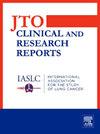塞利那索治疗晚期胸腺瘤和胸腺癌的平行II期临床试验
IF 3.5
Q2 ONCOLOGY
引用次数: 0
摘要
胸腺上皮肿瘤(TETs)是罕见的,包括胸腺瘤(T)和胸腺癌(TC)。在以铂为基础的化疗后,病情进展的患者需要有效的治疗方案。临床前研究表明,核受体输出素-1 (XPO1/CRM1)抑制剂selinexor具有抗肿瘤活性,支持XPO1靶向治疗TETs的临床开发。为了进一步评估selinexor在TETs中的安全性和有效性,我们进行了两项协调平行的II期临床试验。方法:本报告包括两个几乎相同的II期试验,设计为并行运行,分别在美国(NCT03193437)和欧洲(丹麦和法国;NCT03466827)。对两项试验的汇总数据进行分析。两项试验均为非随机、开放标签、双臂II期试验(A组:胸腺瘤,B组:胸腺癌),具有相同的研究设计。组织学证实的晚期不能手术的tet患者在接受至少一种含铂化疗方案治疗后病情进展。在每个4周的周期中,患者接受selinexor 60mg,每周2次,持续3周。为了提高耐受性,在研究期间,起始剂量减少到40毫克,每周两次。主要目标是根据实体瘤1.1的反应评价标准评估总体缓解率(ORR),次要目标包括根据不良事件通用术语标准4.03评估的无进展生存期(PFS)、总生存期(OS)和不良事件(ae)。结果两项试验共纳入31例患者:T组16例,TC组15例。中位年龄为57岁(范围:41-81岁),男性17人,女性14人。既往全身治疗的中位数为2次(范围:1-9次)。起始剂量为60 mg,每周两次,29例(93.5%),40 mg,每周两次,2例(6.5%)。TC组有1例完全缓解(ORR 6.7%;95%可信区间[CI]: 1.2%-29.8%)和两个部分反应(ORR 12.5%;95% CI: 3.5%-36.0%)。在11例(68.6%)T患者和12例(80%)TC患者中,病情稳定为最佳反应。selinexor治疗的中位持续时间为4.5个月(范围:0.1-44.3个月)。最常见的治疗相关不良事件(TRAEs)是恶心(83.8%)、呕吐(45.2%)、贫血(41.9%)、疲劳(38.7%)和虚弱(38.7%)。最常见的3级及以上trae是贫血(16.1%)、血小板减少(12.9%)和虚弱(12.9%)。此外,20名患者(64.5%)因ae需要减少剂量,20名患者(64.5%)需要中断剂量。T组中位PFS为13.6个月(95% CI: 6.3-44.3),中位OS未达到。TC组中位PFS为7.8个月(95% CI: 4.3-15.5),中位OS为15.5个月(95% CI: 13.0-29.9)。由于总体orr较低和预算限制,试验过早停止。结论selinexor在晚期TETs患者中表现出适度的抗癌活性。由于trae发生率高,治疗变得复杂,导致频繁的剂量减少和中断。本文章由计算机程序翻译,如有差异,请以英文原文为准。
Parallel Phase II Clinical Trials of Selinexor in Patients With Advanced Thymoma and Thymic Carcinoma
Introduction
Thymic epithelial tumors (TETs) are rare and include thymomas (T) and thymic carcinomas (TC). Effective treatment options are needed for patients with progressive disease after platinum-based chemotherapy. Preclinical studies demonstrated antitumor activity of selinexor, an inhibitor of the nuclear receptor exportin-1 (XPO1/CRM1), supporting the clinical development of XPO1-targeted therapy for the treatment of TETs. To further assess the safety and efficacy of selinexor in TETs, we conducted two coordinated parallel phase II clinical trials.
Methods
This report includes two nearly identical phase II trials, designed to run in parallel, conducted in the United States (NCT03193437) and Europe (Denmark and France; NCT03466827). Analysis was performed on data pooled from both trials. Both trials were nonrandomized, open-label, two-armed phase II trials (arm A: thymoma, arm B: thymic carcinoma) with the same study design. Patients with histologically confirmed, advanced, inoperable TETs who had progressive disease after treatment with at least one platinum-containing chemotherapy regimen were included. In each 4-week cycle, patients received selinexor 60 mg twice weekly for 3 weeks. To improve tolerability, the starting dose was reduced to 40 mg twice weekly during the study. The primary objective was overall response rate (ORR) assessed by Response Evaluation Criteria in Solid Tumors 1.1, with secondary objectives including progression free survival (PFS), overall survival (OS), and adverse events (AEs) assessed per Common Terminology Criteria for Adverse Event version 4.03.
Results
A total of 31 patients were enrolled between the two trials: 16 with T and 15 with TC. The median age was 57 (range: 41–81) years, with 17 men and 14 women. The median number of previous systemic therapies was 2 (range: 1–9). The starting dose was 60 mg twice weekly for 29 patients (93.5%) and 40 mg twice weekly for two patients (6.5%). There was one complete response in the TC group (ORR 6.7%; 95% confidence interval [CI]: 1.2%–29.8%) and two partial responses (ORR 12.5%; 95% CI: 3.5%–36.0%) in the T group. Stable disease as the best response was observed in 11 patients (68.6%) with T and 12 patients (80%) with TC. The median duration of selinexor therapy was 4.5 (range: 0.1–44.3) months. The most common treatment-related adverse events (TRAEs) were nausea (83.8%), vomiting (45.2%), anemia (41.9%), fatigue (38.7%), and asthenia (38.7%). The most common grade 3 or higher TRAEs were anemia (16.1%), thrombocytopenia (12.9%), and asthenia (12.9%). Furthermore, 20 patients (64.5%) required dose reductions due to AEs and 20 patients (64.5%) required dose interruptions. In the T group, the median PFS was 13.6 months (95% CI: 6.3–44.3), and the median OS was not reached. In the TC group, the median PFS was 7.8 months (95% CI: 4.3–15.5) and the median OS was 15.5 months (95% CI: 13.0–29.9). The trials were halted prematurely due to overall low ORRs and budgetary constraints.
Conclusion
Selinexor demonstrated modest anticancer activity in patients with pretreated advanced TETs. The treatment was complicated by high rates of TRAEs, leading to frequent dose reductions and interruptions.
求助全文
通过发布文献求助,成功后即可免费获取论文全文。
去求助
来源期刊

JTO Clinical and Research Reports
Medicine-Oncology
CiteScore
4.20
自引率
0.00%
发文量
145
审稿时长
19 weeks
 求助内容:
求助内容: 应助结果提醒方式:
应助结果提醒方式:


